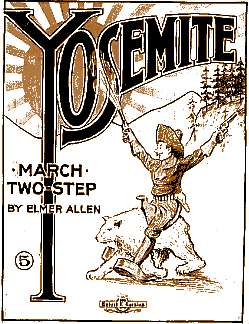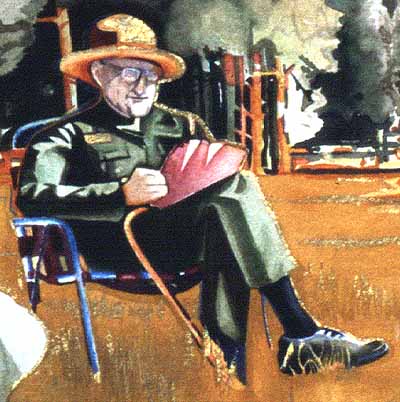VINTAGE
|
 |
| (1874) "Falling Waters of The Yosemite" |
"Falling Waters of The Yosemite" is the second-earliest known and perhaps the most successful Yosemite piece. There have been many different printings of the sheet music, usually with Yosemite scenes on the covers (the one pictured here is the first edition), as it became a favorite with piano teachers. |
| "Falling Waters" might have been surpassed in sales by the "Yosemite March & Two-Step", but, curiously, the words "As Played By Arthur Pryor and his world famous band" are covered with a stripe of metallic gold ink on the sheet music, indicating that the publishers' aspirations to fame had been thwarted. |  (1903) "Yosemite March & Two-Step"
|
| In 1930, Carl Sharsmith was accepted into the Yosemite School of Field Natural History--locally known as the Field School--a chosen handful of the most serious students of the subject, who were also fairly serious about their campfire songs. On August 28, 1994, outside his cabin near Tuolumne Meadows, Dr. Sharsmith sang a bit of one of their songs for my camcorder; I retrieved the rest of the words to "Yosemite" from the 1936 Field School yearbook, which gives the lyricist as Carsten Ahrens. | |
 "The Last Leaf" (Dr. Carl Sharsmith) Detail from a watercolor by Diane Detrick Bopp |
In an interview, Dr. Sharsmith said the song "Smiles" always somehow reminded him of John Muir and Yosemite. Muir sang the songs of his favorite, Robert Burns, as he tramped through the wilderness. Ranger Ferdinand Castillo, long time friend of Dr. Sharsmith's, was fond of the tune "Twilight on the Trail", which we'd sing to each other as I'd roll by his post at Yosemite's east entrance station. In Glenn Hood's rendition of "Home On The Range", the lyric touches (with deep irony) on the recent history of Native Americans in Yosemite, and one is reminded of the far longer history of native Yosemite music yet to be compiled. |
| Wherever people go, they bring their means of interpreting the mysteries they encounter. The means may be poetry, art, pop-culture, science, or music--any of the vast number of ways we see Yosemite commemorated or depicted. Thus do music, culture, and Yosemite become intertwined, producing the unique artifacts presented in "Vintage Songs Of Yosemite". | (1921) "Yosemite, God's Wonderland" |